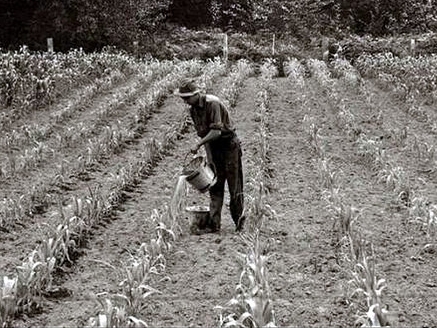Podcast: Play in new window | Download
Subscribe: RSS
As recently as six weeks ago, the Pollyannas of industrial agriculture were all over the industrial media trumpeting the imminent “huge” corn harvest in the United States. They knew it was going to be huge (see, for example, Bloomberg News on May 24) because more US acres were planted in corn this year than ever, and because there is no such thing as global climate change. Well, they didn’t say that second part, but they assumed it. Because if they hadn’t, they might have foreseen the disaster now unfolding.
This week, the US Department of Agriculture put aside its customary cheerleader uniform and pom-poms for sober black attire as it announced: “Persistent and extreme June dryness across the central and eastern corn belt and extreme late June and early July heat from the central Plains to the Ohio River Valley have substantially lowered yield prospects across most of the major growing regions.”
Really? You didn’t see that one coming? Anyone even look at the drought-prediction maps the global-warming cult has been putting out for a couple decades now?
And at that, after one of the largest ever one-month reductions in its corn-harvest estimate– they cut June’s estimate of the harvest by 1.8 billion (!) bushels — the USDA still sounds like a cockeyed optimist. It is still forecasting an average yield of 146 bushels per acre, even while reporting that only 40 per cent of the crop is in good condition as of Monday. A pessimist looking at that number might conclude that, hey, 60 per cent of the crop is in poor condition.
It could be worse. Much worse, and by next week. Right now, this week, the midwestern corn is pollinating, and if there is no rain this week — and none is forecast — the pollination will fail and the losses could be catastrophic.
Already the riverboat gamblers who populate the commodities exchanges are buying in their corn chips big time, looking for an easy profit on the hunger of millions as food prices resume their inexorable rise worldwide, helped along as always by the speculators. Chicago corn futures are at a ten-month high.
If the corn crop does fail substantially, and the failure causes a major spike in food prices worldwide, it will be the first such spike since the spring of last year, a season now commonly referred to as the Arab spring. Wonder what euphemism we’ll use to name the next season of falling governments in hungry countries?
It’s hard to see how we can begin to bring into balance the demand for food and its supply until agencies such as the USDA begin to take into account — honestly and publicly — climate change, the failures of industrial agriculture, the threats posed by overusing synthetic fertilizers and chemicals, the impoverished state of our topsoil and some other pretty serious problems that cheerleaders ignore. And until commodities markets are limited to those who actually sell and buy the commodities along with some reputable and regulated contributors of liquidity.
Don’t bet on it.
